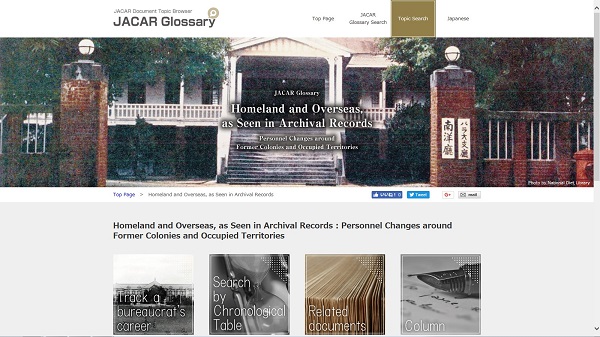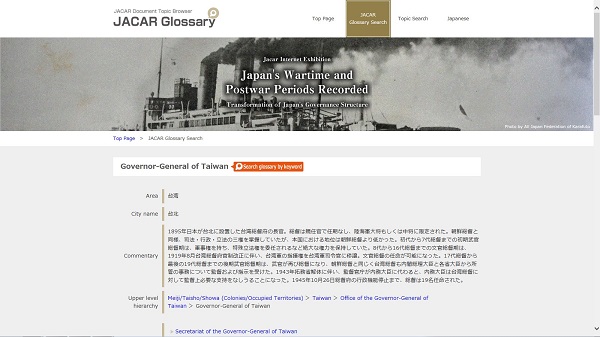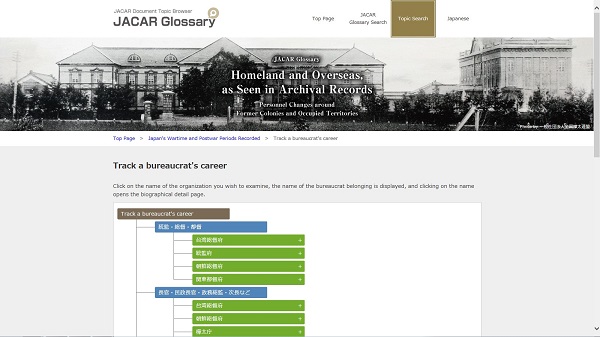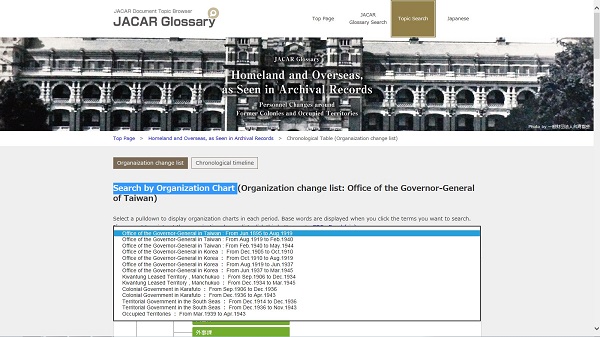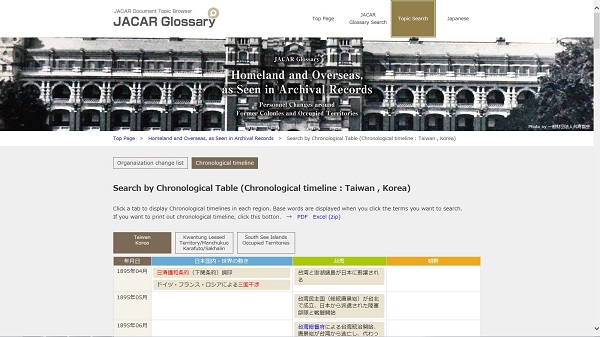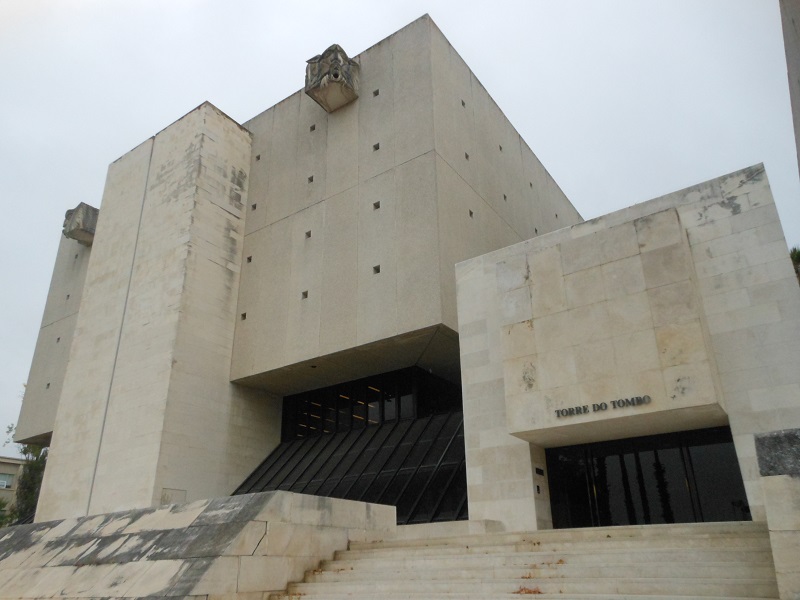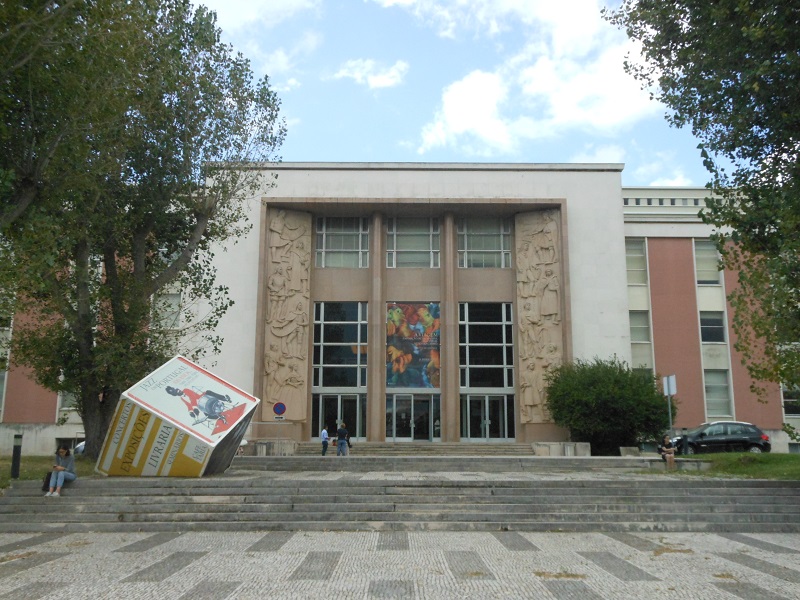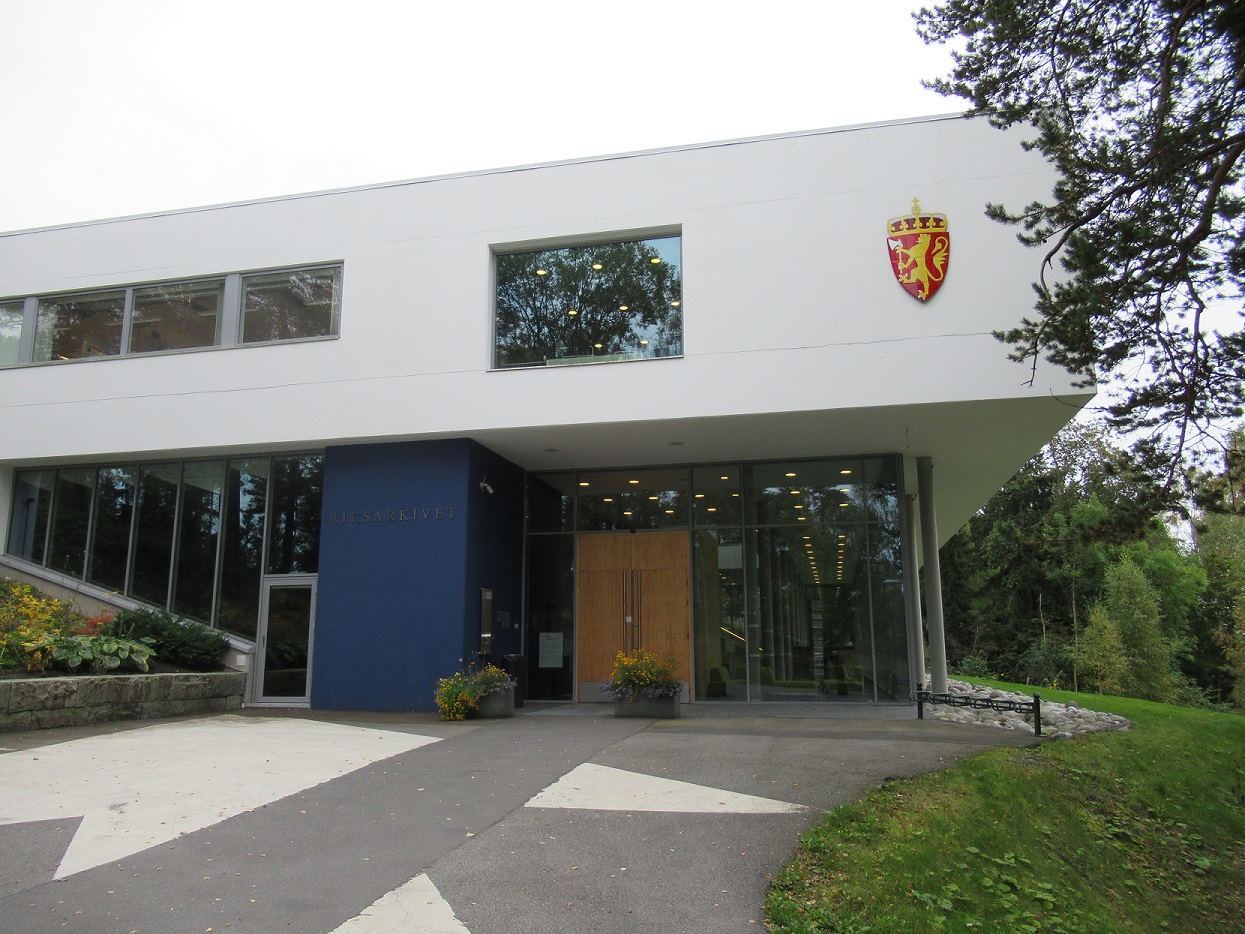

-Documents released on Febrary 27 and March 16, 2018
2. Documents Spotlight "A Survey of Documents Related to Meiji Ishin Overseas" (Ryosuke Asai, Researcher, JACAR)
3. Introduction of New Contents : A special web exhibition
4. Outreach Activities
5. Information on Related Document Holdings
-Portugal / Norway
6. Event Informations on the Related Organs
-National Archives of Japan / Diplomatic Archives of the Ministry of Foreign Affairs
7. Donated Books List
The National Institute for Defense Studies, Ministry of Defense>Navy Records (Rid of Koubunbiko)>0 Horei (Law)>Secret Documents, Minister's Secretariat, Navy Ministry
The National Institute for Defense Studies, Ministry of Defense>Navy Records (Rid of Koubunbiko)>0 Horei (Law)>Accounts Regulations (Secret Regulation)
The National Institute for Defense Studies, Ministry of Defense>Navy Records (Rid of Koubunbiko)>0 Horei (Law)>Accounts (Regulations)
The National Institute for Defense Studies, Ministry of Defense>Navy Records (Rid of Koubunbiko)>0 Horei (Law)>Administrative Order Summary, Appendix
The National Institute for Defense Studies, Ministry of Defense>Navy Records (Rid of Koubunbiko)>0 Horei (Law)>Military Affairs
The National Institute for Defense Studies, Ministry of Defense>Navy Records (Rid of Koubunbiko)>0 Horei (Law)>Medical Affairs
The National Institute for Defense Studies, Ministry of Defense>Navy Records (Rid of Koubunbiko)>0 Horei (Law)>File of Printed Notification, Order and Secret Documents, Minister's Secretariat, Navy Ministry
The National Institute for Defense Studies, Ministry of Defense>Navy Records (Rid of Koubunbiko)>0 Horei (Law)>Periodical Miscellaneous Notifications
The National Institute for Defense Studies, Ministry of Defense>Navy Records (Rid of Koubunbiko)>0 Horei (Law)>Others
Diplomatic Archives of the Ministry of Foreign Affairs> Prewar Diplomatic Records > Series 6: Personnel Affairs > Category 1: Government Organizations and Posts > Section 8: Embassies and Consular Officials
Diplomatic Archives of the Ministry of Foreign Affairs> Prewar Diplomatic Records> Series 6: Personnel Affairs> Category 1: Government Organizations and Posts> Section 9: Miscellaneous
Diplomatic Archives of the Ministry of Foreign Affairs> Prewar Diplomatic Records> Series 6: Personnel Affairs> Category 2: Decorations and awards> Section 1: Orders and Decoration Diplomas
A Survey of Documents Related to Meiji Ishin Overseas
In 2018, Japan will mark the 150th year since the era name was changed to “Meiji” on October 23, 1868. People throughout the country are moving forward with various programs and events connected to “Meiji at 150,” and public interest in the Meiji Ishin (Meiji Restoration” or, as some scholars argue, “Meiji Revolution”) is on the rise.
Even 100 years ago during the Taishō era, there was a general atmosphere of interest in the Meiji Ishin. People seem to have felt that a half century had already passed since those events and they would need to tell future generations about the history of what had occurred. Various organizations and institutions connected to the government, nobility, and private sector put together history-writing projects, and investigations and research into Ishin history flourished.
The Meiji Ishin Documents Compilation Committee (Ishin shiryō hensankai) was one such body established as part of this trend. The Committee was the successor to a group working on a history compilation named Shōmeikai whose members all hailed from the Satsuma and Chōshū domains. Thanks to approaches made by such elder statesmen as Inoue Kaoru and Yamagata Aritomo, the Imperial Diet assented to the Committee being establish to serve as an organization under government jurisdiction that would be responsible for compiling a history of the Meiji Ishin. Imperial Ordinance No. 145 dated May 9, 1911, expressly stated that the job of the committee would be to “take charge of collecting and compiling source materials on the Ishin.”(see Image 1)
![[Image 2]Title : Establishing organizational regulation for the Meiji Ishin Documents Compilation Committee (image 7)](img/025_content02_02.jpg)
[Image 2]Title : Establishing organizational regulation for the Meiji Ishin Documents Compilation Committee (image 7)
![[Image 3]Title : Gaimu-sho Ho No.188/a Business trip and Studying abroad](img/025_content02_03.jpg)
[Image 3]Title : Gaimu-sho Ho No.188/a Business trip and Studying abroad
Many of the executive positions at the Committee such as president and advisor were held by men from Satsuma and Chōshū. Accordingly, the body was fiercely criticized over the possibility that the history it compiled would have a viewpoint that would overemphasize the role of certain domains. As a consequence, the Committee stressed taking a fair-minded perspective in the pursuit of its activities and worked hard to dispel those criticisms. Likewise, Education Minister Komatsubara Eitarō stressed in the request for Cabinet review (kakugi seigisho) submitted prior to the Committee's establishment the need to collect "accurate materials" regarding the Meiji Ishin.(see Image 2)
The Committee's administrative affairs were handled by the Meiji Ishin Documents Compilation Secretariat (Ishin shiryō hensan jimukyoku), established “in order to manage [the Committee's] business.” The Secretariat had two types of job, an Ishin Documents Compiler (Ishin shiryō hensankan) and an Ishin Documents Assistant Compiler (Ishin shiryō hensankanho). These men worked vigorously to collect and collate historical materials. One matter of particular interest here is the search they conducted for materials overseas.
From the start, the Secretariat was dispatching compilers to all parts of Japan to collect historical documents. As the Shōwa period (1925-1989) began, the scope of those collections was expanded to include locations overseas and plans were laid to search for Restoration-related documents in foreign countries.
Issue number 188 of the Bulletin of the Ministry of Foreign Affairs (Gaimushō-hō) -a regularly produced Ministry in-house publication- reported that a writ of appointment dated September 20, 1929, had been issued for Ishin Documents Compiler Fujii Jintarō to visit Europe and the United States “for the purpose of historiographical research.” With the title of Ministry of Education Overseas Researcher, Fujii was sent on a trip to England, Germany, France, the Netherlands, and the U.S. He set sail from Kobe in February 1930, and returned by way of Yokohama in April 1931.(see Image 3)
In his research, Fujii appears to have had the help of Japanese diplomatic missions in the countries he visited. On December 7, 1931, Committee President Kaneko Kentarō sent a letter to Foreign Affairs Minister Shidehara Kijūrō expressing his gratitude that thanks to the “good offices” of the diplomatic missions in the countries that Fujii visited he received the full benefit of “special treatment cordially delivered” by the governments of those countries in his “search and collection of Meiji Ishin Documents overseas.” Kaneko also made mention in his missive that Fujii would be “returning home having collected numerous historical documents related to the Meiji Ishin that are entirely appropriate,” which would suggest that his investigations resulted in a successful accumulation of items. (see Image 4)
On the other hand, Fujii himself offered a perspective on his investigations that differed from Kaneko’s. In correspondence dated April 16, 1931, Fujii wrote that he had been able to find documents related to Japan’s history “in quantities greater than I had expected.” However, he also noted that he had spent less than one year in foreign countries, admitted that he had been “unable to make a record of a more than half” of the materials, and spoke of wanting to “someday make this trip again.”
The Meiji Ishin Documents Compilation Secretariat made plans to publish a translation of the collected documents that were in European languages. The materials they selected for this included such items as the personal recollections of envoys who had been stationed in Japan during the end of the shogunate (bakumatsu) in the mid 19th century. One of the publications that resulted from this effort was a translation of British envoy Ernest Satow’s book A Diplomat in Japan, published in March 1938 under the Japanese title Ishin Nihon gaikō hiroku [A confidential diplomatic memoir of Restoration Japan].
Today, scholars are quite active in doing research on Japan-related documents in foreign countries, and the full picture of those materials is coming into focus. While the Meiji Ishin Documents Compilation Committee’s survey of relevant materials overseas may not have fully measured up in the task of collecting documents, when comes to having gotten a grasp of what sort of materials could be found abroad in the prewar years it can still fairly be described as a great success.
[References]
・Eiichi Ozawa, Conversation Meeting about Research of the Meiji Ishin, The Nippon-rekishi No.246, 1968.
・Hiroshi Hakoishi, The Process of Establishing for the Meiji Ishin Documents Compilation Committee, The Tochigi journal of Japanese history No.15, 2001.
・Osamu Horiguchi, The Issue of Merger of the Meiji Ishin Documents Compilation Committee and Ad Hoc Bureau for Compilation of the Official Biography, Bulletin of the Culture Research Institute No.36, 2005.
(Ryosuke Asai, Researcher, JACAR)
Special web exhibition "Homeland and Overseas, as Seen in Archival Records: Personnel Changes around Former Colonies and Occupied Territories
This web exhibition looks at Japan's former colonies and occupied territories from the perspective of organizational changes in the governing institutions Japan established there, personnel movements among such institutions in the Japanese homeland and the former colonies and occupied territories, and the careers of bureaucrats who worked in the former colonies. Its specific goal is to shed light on what impact the existence of these former colonies and occupied territories had on Japan's government institutions and bureaucracy.
-Overseas
|
March 22-27
|
Held a booth exhibition at the annual conference of AAS in Washington D.C. Had discussions about researching archival documents with staff of the U.S. National Archives and Records Administration, Archives II. Held discussions on researching archival records with staff of the Library of Congress. Had discussions about researching archival documents with U.S. Holocaust Memorial Museum. Made a research of archival records in National Air and Space Museum.
|
-Visitors
|
Febrary 28, 2017
|
Mr. Nasir Ahmad Andisha (Deputy Foreign Minister), Mr. Mohammad Ayoub Samadi (Deputy Director General of Diplomatic Archive), Mr. Ghulam Mustafa Zaka (Executive Assistant for Diplomatic Archive Digitization Project) from Afghanistan
|
|
March 27
|
Mr. Wu Micha (President of Academia Historica), Ms. Zhou Xiaowen (Chief, Department of Preservation and General Service), Ms. Yan Shujuan (Chief, Reading Service Section, Department of Preservation and General Service) from Taiwan
|
The Condition of Japan Related Materials in Portugal
The National Archives of Portugal is an organization that preserves and services the historical documents of Portugal. The organization has a long history, dating back to the Royal Archive in the 14th century, and spanning the 1755 Lisbon Earthquake and several revolutions. The National Archives of Portugal owns about 100km in documents. These documents are searchable in paper catalogs as well as in a rapidly expanding online system. You can search for documents with keywords (but only in Portuguese) and view some in the database. The National Archives of Portugal includes documents that illustrate the relationship between Japan and Portugal. For example, in a collection of Oliveira Salazar, prime minister of Portugal in the mid-20th century, there are reports about Japanese activities directed towards Timor and Macau from 1930 to 1940. Some of the archive’s digital photographs include images of Japanese statesmen visiting Portugal. Among others, there are March 1926 pictures of Minister Extraordinary and Plenipotentiary Tamekichi Ota in Portugal as well as images of Prince Takamatsunomiya Nobuhito visiting in November 1930.
The National Library of Portugal collects, preserves, and promotes the diffusion and valorization of the heritage held at the largest library in the country, covering almost ten centuries of Portuguese history and culture. The library owns about two million books that can be searched through an online catalog. The collection includes historical materials concerning Japan. For example, journals written by 17th century missionaries and materials related/from to Japanese folding screens organized and introduced by Nakamura Tadashi in 1983. In addition, there are four letters from Emperor Meiji to the then King of Portugal. The contents of the letter are 1) to thank D. Carlos I for a letter and medal, 2) the marriage of Princess Masako and Prince Takedanomiya Tsunehisa, 3) a wish to entrust Inagaki Mitsujiro as minister extraordinary and plenipotentiary of Portugal, 4) and congratulation to Manuel II for inheriting the throne along with condolences over the assassination of his father and brother. Such documents tell the relationship between the heads of Japanese and Portugal.
Japan-Related Materials Held in Norwegian Collections
The National Archives of Norway (Riksarkivet) were founded in 1817. The facility comprises the main archives in Oslo, eight regional state archives located around the country, a separate archive dedicated to material regarding the indigenous Sámi people, and the Norwegian Health Archives.
The Archives do not contain many Japan-related materials. However, of particular interest among those items they do contain are the documents related to “Manchukuo.” While Norway did not recognize the state of Manchukuo, it did have a consulate in Dairen (Dalian) and posted an honorary consul to Yingkou (note 1). For this reason, the National Archives do contain documents on consular matters related to Manchukuo as well on matters of trade with Japan, Manchukuo, and China from the prewar and wartime periods. Items can also be found connected to the petroleum trade with Manchukuo. Some of the materials in the Archives have been digitized and can be searched and viewed through the Archives’ website (note 2).
Note 1: JACAR, file name “Chapter 8: Foreign Consulates Located in Manchukuo and Manchukuo Diplomatic Organizations Located in Foreign Countries” (reference code: >> B02130128500 )
Note 2: http://www.arkivportalen.no/side/forside
As a rule, information on the website is presented in Norwegian. However, keyword searches for terms such as “Japan” and “Manchoukuo” will yield lists of relevant documents.
|
Period
|
Event
|
About
|
Link
|
|
March 31 to May 6, 2018
|
Special Exhibition “The Last Fight of the Edo Shogunate: Scholastic and Military Reforms at the End of the Edo Period.”
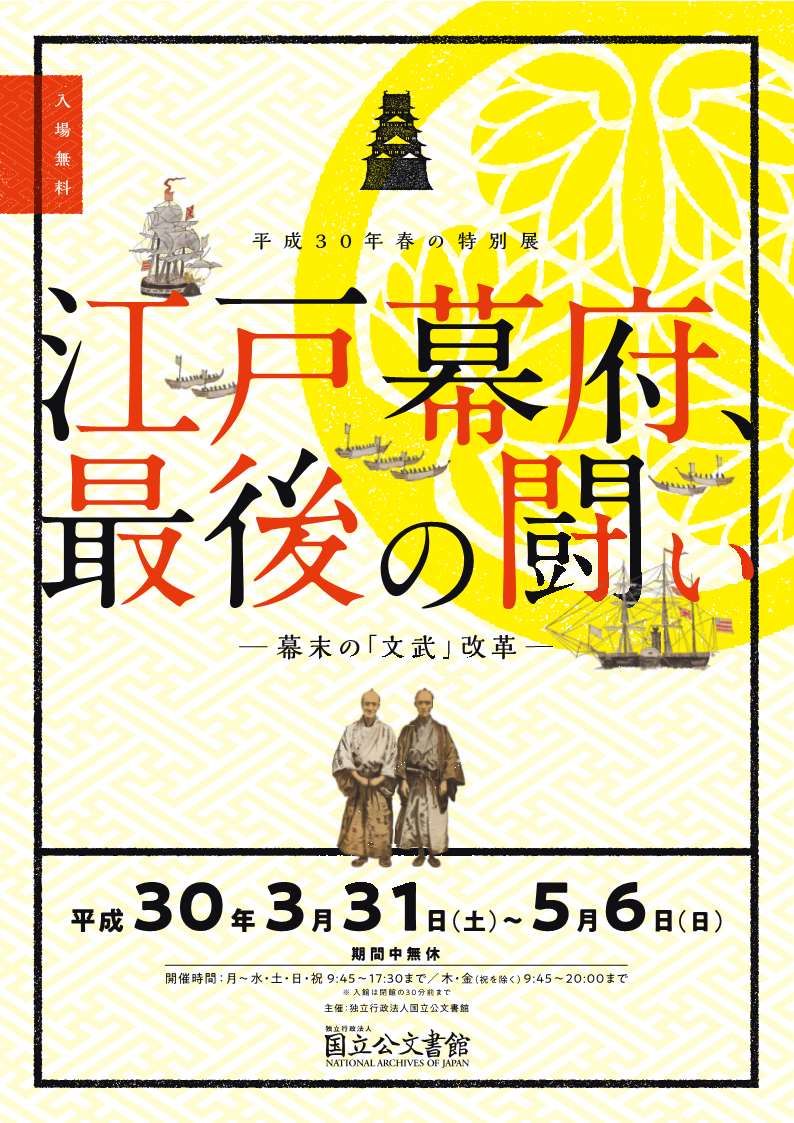 →PDF (1.5MB) |
This year marks the 150th Anniversary of the 1868 Meiji Restoration. This spring, a National Archives of Japan special exhibition explores reforms of the Edo Shogunate with the Tamon Yagura Monjo. The exhibit focuses on how the Shogunate at the end of the Edo period was altered by modernization and the Meiji Restoration. The exhibit also offers background on the political reforms and the shogun’s vassals, who became active in the Meiji government.
|
|
|
Period
|
Event
|
About
|
Link
|
|
January 11 to May 31, 2018
|
Exhibition Commemorating the 150th Anniversary of the Meiji Restoration: Japanese Diplomacy in the Meiji Era as Reflected in Sovereign and Personal Letters.
|
The coming year marks the 150th Anniversary of the Meiji Restoration in 1868. This exhibition displays sovereign and personal letters exchanged between the Emperor Meiji and various heads of state to trace the story of Japanese diplomacy during the Meiji Era.
|
|
Books refering to JACAR or documents from its database donated in current year are as follows.
|
編著者名
|
書 名
|
出版元
|
出版年
|
|
横浜市史資料室・編
|
報告書 横浜の戦争 市民と兵士の記録
|
横浜市史資料室
|
2017
|
|
安細和彦・著
|
私のラバさん酋長の娘 遙かなるマーシャル諸島
|
駱駝舎
|
2017
|
|
拓殖大学創立百年史編纂室・編
|
拓殖大学百年史 通史編2 昭和前期
|
拓殖大学
|
2017
|
|
拓殖大学創立百年史編纂室・編
|
拓殖大学百年史 通史編3 昭和後期平成期
|
拓殖大学
|
2018
|
|
岩沼市史編纂委員会・編
|
岩沼市史 第7巻 資料編Ⅳ 近代
|
岩沼市
|
2017
|
|
村田雄二郎・監修,青山治世・関智英・編
|
『順天時報』社論・論説目録
|
東洋文庫
|
2017
|
|
板垣竜太・鄭昞旭・編
|
日記からみた東アジアの冷戦(同志社コリア研究叢書3)
|
同志社コリア研究センター
|
2017
|
|
相模原市教育委員会教育局生涯学習部博物館・編
|
相模原市史 近代資料編
|
相模原市
|
2017
|
|
瀬戸内町教育委員会・編
|
瀬戸内町内の遺跡2 近代遺跡 分布調査編(瀬戸内町文化財調査報告書第6集)
|
瀬戸内町教育委員会
|
2017
|
|
学習院大学国際研究教育機構・編
|
アジアを観る 学習院大学所蔵古写真・絵葉書・ガラス乾板
|
学習院大学
|
2015
|
|
外務省・編
|
日本外交文書 占領期第1巻(占領政策への対応)
|
六一書房
|
2017
|
|
外務省・編
|
日本外交文書 占領期第2巻(外交権の停止・日本国憲法の制定・中間賠償・他)
|
六一書房
|
2017
|
|
小林茂・編
|
近代日本の海外地理情報収集と初期外邦図
|
大阪大学出版会
|
2017
|
|
村山富市・和田春樹・編
|
デジタル記念館 慰安婦問題とアジア女性基金
|
青灯社
|
2014
|
|
粟倉大輔・著
|
日本茶の近代史 幕末開港から明治後期まで
|
蒼天社出版
|
2017
|
|
楊海英・編
|
モンゴル人ジェノサイドに関する基礎資料(10) 紅衛兵新聞(2)
|
風響社
|
2018
|
|
神奈川県立歴史博物館・編
|
岩橋教章・章山に関する総合的研究(神奈川県立歴史博物館総合研究平成26年度~29年度 総合研究成果報告書)
|
神奈川県立歴史博物館
|
2017
|
[Postscript]
Please email us if you would be interested in a member of JACAR presenting at your organization about our institution and its resources. We go to schools, research conferences, and a range of other institutions.
Leaflets about JACAR are available in English, Japanese, Chinese, and Korean, so if you would like copies, please contact us.
An email about the JACAR Newsletter has been sent to everyone who requested a copy as well as those who have exchanged business cards with JACAR staff members. If you do not wish to receive future e-mails, please let us know.
[Reference] TEL : +81-(0)3-5805-8801 E-MAIL : jacar_enquire@archives.go.jp


![[Image 1]Title : Script signed by the Emperor/1911/Imperial Ordinance No.145/the Government organization of the Meiji Revolution Historical Records Compiling (image 2 & 3)](img/025_content02_01.jpg)
![[Image 4]Title : 2. Collection of revolution materials From December, 1931 (image 2 ~ 7)](img/025_content02_04.jpg)

